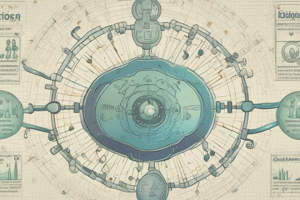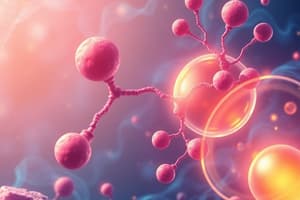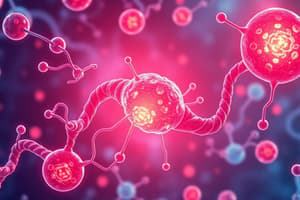Podcast
Questions and Answers
What is the primary function of the urea cycle?
What is the primary function of the urea cycle?
- Detoxifies ammonia and maintains nitrogen balance (correct)
- Transport of amino acids across membranes
- Synthesis of fatty acids
- Converts glucose into glycogen
Which enzyme mediates the formation of carbamoyl phosphate in the urea cycle?
Which enzyme mediates the formation of carbamoyl phosphate in the urea cycle?
- Carbamoylphosphate synthetase I (correct)
- Argininosuccinate synthase
- Ornithine transcarbamylase
- Arginase
Which compound acts as the second nitrogen donor in the formation of argininosuccinate?
Which compound acts as the second nitrogen donor in the formation of argininosuccinate?
- Ornithine
- Glutamine
- Aspartate (correct)
- Citrulline
In which cellular location do the first two steps of the urea cycle occur?
In which cellular location do the first two steps of the urea cycle occur?
What is produced alongside argininosuccinate during its formation?
What is produced alongside argininosuccinate during its formation?
Which step involves the transport of citrulline from the mitochondria?
Which step involves the transport of citrulline from the mitochondria?
What is the final product of the urea cycle that is excreted from the body?
What is the final product of the urea cycle that is excreted from the body?
How many ATP molecules are consumed in the formation of carbamoyl phosphate?
How many ATP molecules are consumed in the formation of carbamoyl phosphate?
Describe the overall significance of the urea cycle in the human body.
Describe the overall significance of the urea cycle in the human body.
What is formed when carbamoyl phosphate reacts with ornithine?
What is formed when carbamoyl phosphate reacts with ornithine?
Explain the role of aspartate in the formation of argininosuccinate.
Explain the role of aspartate in the formation of argininosuccinate.
What is the overall reaction for the formation of carbamoyl phosphate?
What is the overall reaction for the formation of carbamoyl phosphate?
Identify the cellular locations where the urea cycle processes take place.
Identify the cellular locations where the urea cycle processes take place.
How many ATP molecules are involved in the reaction that forms argininosuccinate?
How many ATP molecules are involved in the reaction that forms argininosuccinate?
Discuss the importance of the mitochondrial ornithine transporter protein.
Discuss the importance of the mitochondrial ornithine transporter protein.
What are the products of the reaction that forms argininosuccinate?
What are the products of the reaction that forms argininosuccinate?
Define the term 'carbamoyl phosphate' within the context of the urea cycle.
Define the term 'carbamoyl phosphate' within the context of the urea cycle.
Summarize the overall outcome of the urea cycle process.
Summarize the overall outcome of the urea cycle process.
Flashcards are hidden until you start studying
Study Notes
Unit V: Metabolism of Proteins and Nucleic Acids
- Focus on catabolism and anabolism of proteins and nucleic acids.
- Key amino acids studied: Glutamine, Tryptophan, Cysteine, Proline.
- Nucleic acids include structures of purines and pyrimidines, as well as nucleosides and nucleotides.
Catabolism
- Urea Cycle:
-
Occurs in the liver to convert toxic ammonia into urea for excretion via urine.
-
Crucial for detoxifying ammonia and maintaining nitrogen balance.
-
Comprises five steps happening in mitochondria and cytoplasm of liver cells.
-
Mitochondrial Steps:
- Formation of Carbamoyl Phosphate.
- Formation of Citrulline.
-
Cytoplasmic Steps:
- Formation of Argininosuccinate.
- Formation of Arginine.
- Formation of Urea.
-
-
Formation of Carbamoyl Phosphate
- Ammonia (NH₃) combines with bicarbonate (HCO₃⁻) and two ATP molecules.
- Reaction catalyzed by Carbamoylphosphate synthetase I (CPS I).
- Equation:
2ATP + HCO3− + NH3 → 2ADP + Pi + carbamoyl.
Formation of Citrulline
- Carbamoyl phosphate reacts with ornithine to produce Citrulline.
- Citrulline is transported from mitochondria to cytoplasm via mitochondrial ornithine transporter protein.
Formation of Argininosuccinate
- Citrulline combines with aspartate in an ATP-dependent reaction to yield argininosuccinate.
- The second nitrogen atom provided by aspartate.
- Reaction involves argininosuccinate synthase.
- Equation:
Citrulline + Aspartate + ATP → Argininosuccinate + AMP + Pi.
Anabolism
- Focus on the synthesis pathways for amino acids, purines, and pyrimidines, including de novo and salvage pathways.
Unit V: Metabolism of Proteins and Nucleic Acids
- Focus on catabolism and anabolism of proteins and nucleic acids.
- Key amino acids studied: Glutamine, Tryptophan, Cysteine, Proline.
- Nucleic acids include structures of purines and pyrimidines, as well as nucleosides and nucleotides.
Catabolism
- Urea Cycle:
-
Occurs in the liver to convert toxic ammonia into urea for excretion via urine.
-
Crucial for detoxifying ammonia and maintaining nitrogen balance.
-
Comprises five steps happening in mitochondria and cytoplasm of liver cells.
-
Mitochondrial Steps:
- Formation of Carbamoyl Phosphate.
- Formation of Citrulline.
-
Cytoplasmic Steps:
- Formation of Argininosuccinate.
- Formation of Arginine.
- Formation of Urea.
-
-
Formation of Carbamoyl Phosphate
- Ammonia (NH₃) combines with bicarbonate (HCO₃⁻) and two ATP molecules.
- Reaction catalyzed by Carbamoylphosphate synthetase I (CPS I).
- Equation:
2ATP + HCO3− + NH3 → 2ADP + Pi + carbamoyl.
Formation of Citrulline
- Carbamoyl phosphate reacts with ornithine to produce Citrulline.
- Citrulline is transported from mitochondria to cytoplasm via mitochondrial ornithine transporter protein.
Formation of Argininosuccinate
- Citrulline combines with aspartate in an ATP-dependent reaction to yield argininosuccinate.
- The second nitrogen atom provided by aspartate.
- Reaction involves argininosuccinate synthase.
- Equation:
Citrulline + Aspartate + ATP → Argininosuccinate + AMP + Pi.
Anabolism
- Focus on the synthesis pathways for amino acids, purines, and pyrimidines, including de novo and salvage pathways.
Studying That Suits You
Use AI to generate personalized quizzes and flashcards to suit your learning preferences.





